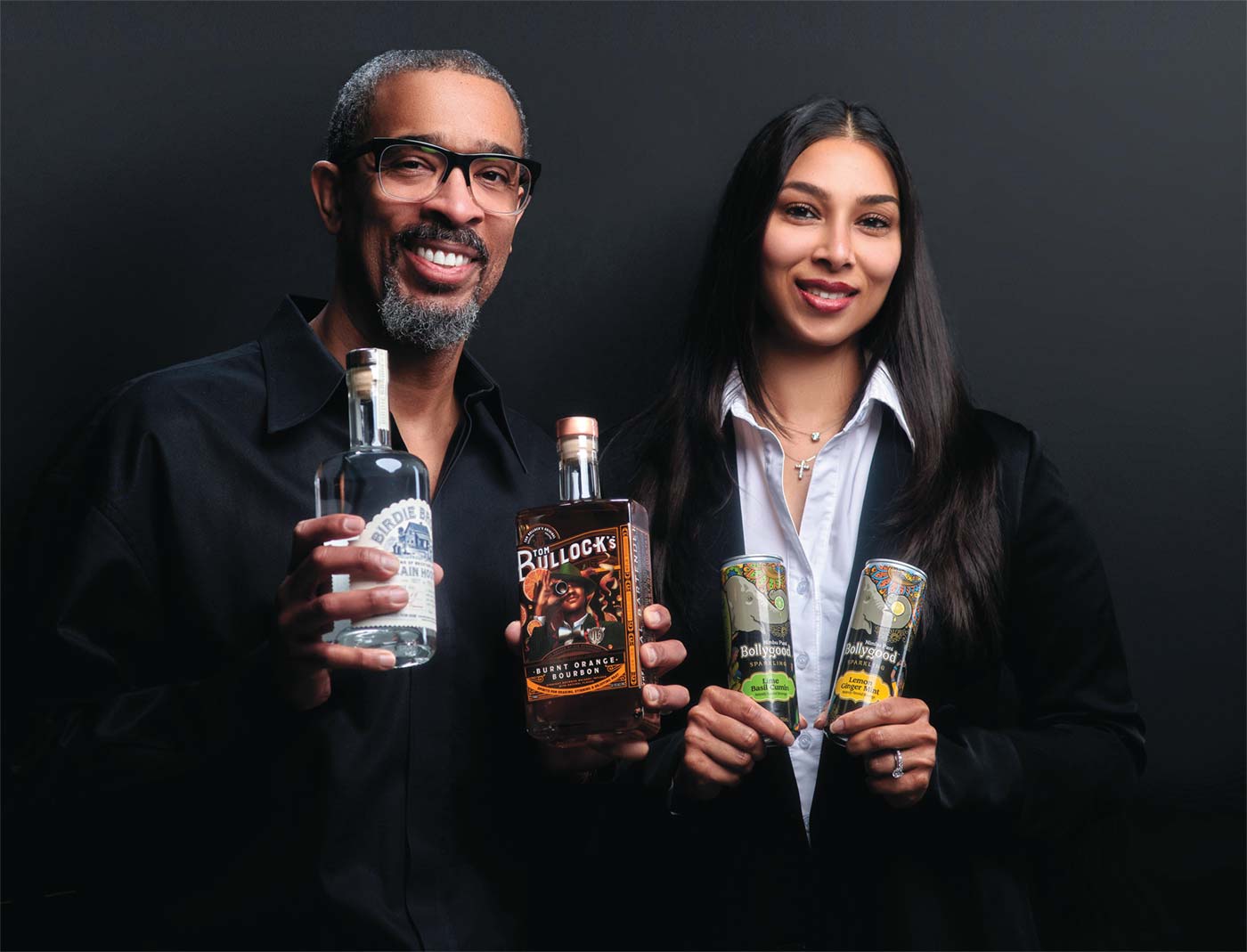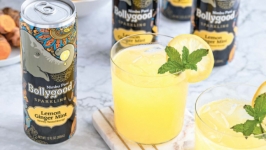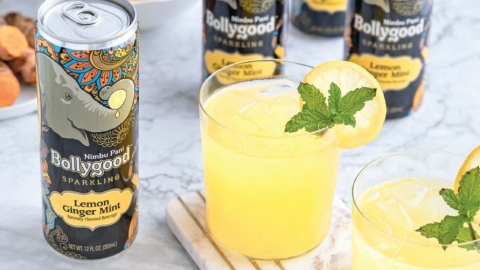Refreshing Indian Lemon Water Boasts a Splash of Heritage
Nimbu pani, a simple and delicious concoction of citrus, spices, salt and water, is popular throughout South Asia—from India to the Maldives to Sri Lanka. The thirst quencher is a traditional beverage to beat the heat of the tropics. Now, it’s making the leap from India to Indiana as a local brand steps up to help Americans soothe our panting palates.
On a Zoom call, I meet entrepreneur Maxine Henderson, a 46-year-old daughter of Indian emigrants, former electrical engineer, mother of four and wife of retired NBA player Alan Henderson. She hopes her drink—named Bollygood, a play on the “Bollywood” moniker for movies from India—will become as well-known here as it is in her parents’ homeland. According to her press release, it may be the first canned nimbu pani (literal translation: lemon water) marketed on our shores. Born and raised in Canada, Henderson recalls her parents taking the family on trips to their home region, the coastal state of Kerala in southern India. Located on the Malabar Coast, the locale is known for its rich food culture. It even has the nicknames “Spice Garden of India” and “Land of Coconuts.” As parents, they wanted to imbue a sense of their former country into their growing family, so they visited annually. On a particular familial excursion, the group visited the famed Taj Mahal, closer to Nepal than the Arabian Sea. She remembers, “It was so hot, maybe over 100°, and my older sister fainted. And the first thing that was brought to her was [this] lemon drink. Our mom would whip that up fast for us if we ever needed something. We weren’t really a big fan of sweet things, but we found it refreshing and hydrating.”
The drink has an extensive history dating back to the first century, largely because sugar and lemon both began their cultivation in India. Sugar-making (extracting juice from the sugarcane plant) started around 4,000 BCE in the country’s tropical areas. According to The Nibble, a digital specialty food publication, lemon tree farming was documented in a 10th-century book on agriculture. Other citrus, such as mandarins and citrons, was already being grown.
“Lemon water” comes in as many variations as there are tastes. Today, throughout India, parched people can find nimbu pani stands on many streets. “There are many ways to make nimbu pani,” Henderson says. “My twist on it was to add the sparkling water, to give it some effervescence. Also pink Himalayan salt. I didn’t feel the more traditional use of black salt would be palatable for Americans.” Henderson refers to kala namak, a salinated mineral used throughout Southeast Asia known for its sulfurous smell. I concur.
In researching this piece, I watched online videos of these omnipresent nimbu pani shops. Overheated customers surround what seems like a makeshift table. At the same time, the vendor chops ice and fills the glasses with water, lemon and spices such as amchoor (powdered sour mango), black pepper, ginger or anar dana (dried pomegranate seed powder) and black salt. Henderson, however, created her beverages for the less adventurous and easier-to- market flavors such as lemon, basil and mint in one version and another with lime, basil and cumin. Having never been to India but traveled to The Maldives, I recall arriving at the hotel after a grueling 24-hour journey. Upon arrival, the concierge presented us with a refreshing nimbu pani topped with colorful flowers and cold towels to wipe away the grime of the trip.
However, that was then, and this is now: Henderson, north of Indianapolis, sits on one side of the computer screen, and I’m in my home office looking at a clear blue sky with a breeze brushing through the cascading willow just outside the window. I delightfully partake of my Bollygood of lemon, ginger and mint. It’s lightly bubbled with a bit of salt and a dash of pure cane sugar to begin and then a little palate cleanse of ginger—not too much— touched with refreshing mint. I try to picture myself roasting under blistering sun and dust and imagine whether this would cure that ill of parchedness. Considering the Midwest is currently baking in oppressive heat, I think it does the trick nicely.
I think to myself, why is Bollygood the first attempt of this product on this side of the hemisphere? I believe her husband, Alan, a former Atlanta Hawks forward, might have the answer on a couple of points. “Oftentimes people will put you in a box. Me as a former athlete or Max as an engineer. And [they] think that’s all you can do. But I think she is showing everyone that the only limits to what you can do is what you tell yourself you can or cannot do.”
Her mother, Mary Mukkattu, 82, echoes her son-in-law. She said in an email, “I knew Maxine would be a successful entrepreneur when I saw the cans for the first time. She has a self-determined personality. I was happy to see her highlighting our Indian culture.” I asked Henderson why she thinks it’s so popular in India. Does she have any idea? She paused before answering, “[At the soda shop]), it takes time to put this together. You have to measure the ingredients in water and, you know, there are lines of people. It’s not so easy [to make], but it’s refreshing.”
The distinctive artwork provided on Bollywood cans brings in her Indian family experiences of traditional paisley patterns, Indian dancers practicing Bharatanatyam, and elephants on a black background with bright colors representing her family’s rich spices and heritage.
The pair know that her herbaceous tonics also have uses as cocktail mixers for products her husband distributes at Henderson Spirits Group. Having entered the beverage industry a few years prior, he supports his wife and her Bollygood with the knowledge gained, making his way through.
“I just think it is pretty cool that she was able to take a product that she related to her culture, add her own special twist and get it to market. It isn’t easy, but once she sets her mind to do something she can be pretty determined.”
Bollygood is available for purchase at BollyGood.com and Amazon. They off er a 10% discount to those who subscribe for monthly deliveries.
ALAN HENDERSON COURTS CHANGE AT THE BAR
What do you do when you retire as a professional National Basketball Association player? If you’re Alan Henderson, formerly of the NBA’s Atlanta Hawks, you create an artisanal liquor company around African Americans who handcrafted it before. When Henderson started the company in 2013, he recognized a lack of diversity in the spirits-making industry, both now and historically. His investigations led him in 2020 to launch Birdie Brown Plain Hooch, named after one of the few Black female homesteaders and home-distillers of great “hooch” (Prohibition slang for bootlegged alcohol). His next creations were in honor of Tom Bullock, head bartender at the St. Louis Country Club. The mixologist is most notable for writing the 1917 book The Ideal Bartender, containing 173 cocktail recipes. His name graces the Kentucky-made bourbon Tom Bullock’s Burnt Orange and Old Tom gin, concocted in the United Kingdom. Henderson’s mantra “Diversifying the Bar” doesn’t only mean in what we drink but also that these pioneers weren’t allowed in many establishments. HendersonSpiritsGroup.com









